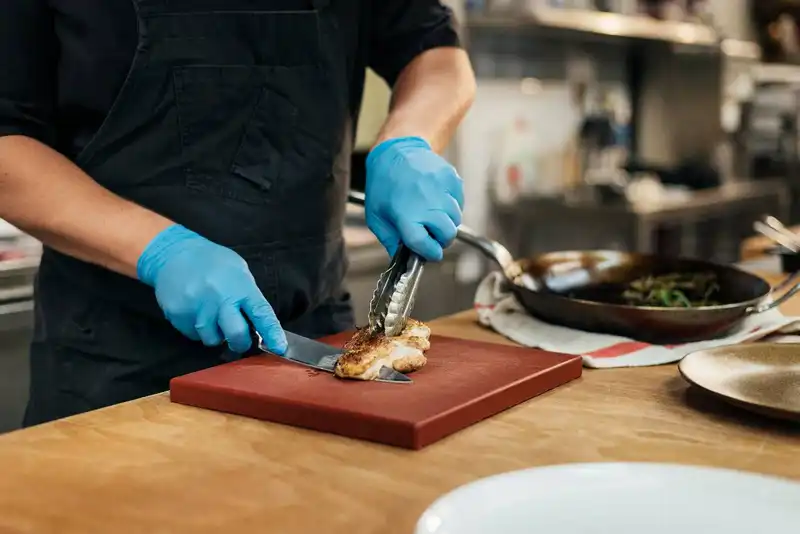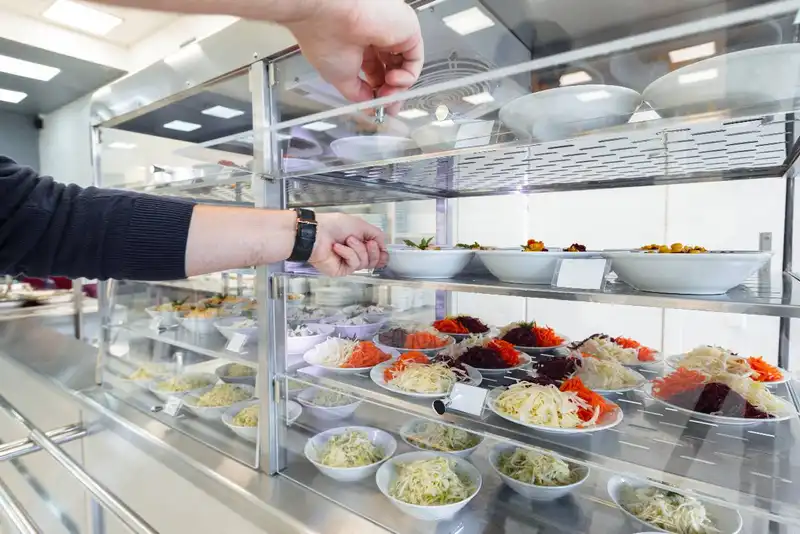What are the basic principles of food safety?
The core principles include cleanliness, proper cooking, temperature control, and preventing cross-contamination. Following these consistently reduces the risk of contamination.
Food Safety Practices for Small Restaurants
Risks of Poor Food Safety
Running a small restaurant is rewarding, but it comes with many challenges. One of the most important - yet sometimes overlooked - tasks is keeping your food safe. Every year, the Centers for Disease Control and Prevention (CDC) estimates that 1 in 6 Americans gets sick from food-borne illness, and even a small mistake in your kitchen can put your customers at risk. A single incident could lead to health problems for your guests, fines from health inspectors, or damage to your restaurant's reputation.
The good news is that food safety doesn't have to be complicated. Small restaurants can protect their customers and staff with practical, everyday steps that fit into normal kitchen routines. It's about building simple habits- keeping surfaces clean, storing food properly, monitoring temperatures, and making sure everyone handling food follows basic hygiene rules.
Understanding Food Safety Basics

Before implementing specific practices, it's important to understand the basics of food safety. At its core, food safety is about preventing harmful bacteria, viruses, and other pathogens from contaminating the food you serve. Contaminated food can cause illnesses, which not only affect your customers' health but can also lead to lost business and fines. According to the FDA, poor food handling is a leading cause of food-borne illness outbreaks in restaurants.
The key principles of food safety include cleanliness, proper cooking, temperature control, and avoiding cross-contamination. Cleanliness means washing hands, utensils, and surfaces regularly to remove bacteria. Proper cooking ensures that harmful microbes are killed; for example, chicken should reach an internal temperature of 165F (74C). Temperature control is essential both for hot foods, which should stay above 140F (60C), and cold foods, which should stay below 40F (4C) to prevent bacterial growth. Cross-contamination happens when bacteria from raw foods, like meat, transfer to ready-to-eat foods, and it's one of the most common mistakes in small kitchens.
For small restaurant owners, understanding these basics is the foundation for every food safety practice. Once you know the "why" behind these rules, it becomes easier to implement consistent routines in your kitchen. By keeping these principles in mind, you can reduce risks and create a safer environment for both your staff and customers.
Elevate Food Safety, Simplify Compliance!
Experience Seamless Food Safety with Altametrics!
Personal Hygiene and Staff Training
One of the simplest - and most effective - ways to prevent food-borne illnesses in your restaurant is through proper personal hygiene and staff training. Even a small lapse, like touching food with unwashed hands, can introduce harmful bacteria into your kitchen and onto your customers' plates. According to the CDC, poor hand-washing is a major factor in about 20% of reported food-borne illness outbreaks, highlighting just how critical this area is.
Personal hygiene starts with your staff. Everyone handling food should wash their hands thoroughly with soap and warm water for at least 20 seconds before starting work, after using the restroom, and after touching raw ingredients. Gloves can provide an extra layer of protection, but they are not a substitute for hand-washing. Staff should also avoid wearing jewelry that can trap bacteria and keep fingernails short and clean. Sick employees should stay home, as even mild symptoms like a cough or stomach upset can spread pathogens.
Training is equally important. A clear, simple training program ensures that every team member knows what's expected and why it matters. This can include demonstrations of proper handwashing, instructions for using gloves and utensils correctly, and regular refreshers on hygiene practices. Small restaurants can use posters or checklists in the kitchen as visual reminders, which can be surprisingly effective.
By focusing on hygiene and training, restaurant owners create a culture of food safety where staff understand that protecting customers' health is everyone's responsibility. The result is not only safer food but also a more confident, efficient team that can maintain high standards even during busy service hours.
Kitchen Cleanliness and Sanitation Practices
Maintaining a clean and sanitary kitchen is essential for preventing food-borne illness in small restaurants. Even small lapses can allow bacteria to grow on surfaces, utensils, or equipment, which can then contaminate food. According to the FDA, unsanitary kitchen conditions are a leading cause of food safety violations in small restaurants. Here are the key steps to keep your kitchen safe -
1. Create a Cleaning Schedule
High-touch surfaces like counters, cutting boards, and handles should be cleaned and sanitized multiple times a day. Equipment such as slicers, mixers, and refrigerators also needs regular attention.
2. Understand Cleaning vs. Sanitizing
Cleaning removes visible dirt, while sanitizing kills harmful bacteria and pathogens. Use food-safe sanitizers or a simple bleach solution for surfaces, utensils, and equipment.
3. Organize Your Kitchen
Keep ingredients properly stored and separate raw from cooked foods. Use color-coded cutting boards, labeled containers, and designated prep areas to prevent cross-contamination.
4. Use Affordable Tools
Even small restaurants can maintain cleanliness with low-cost items like microfiber cloths, sanitized sponges, and labeled spray bottles. These make daily cleaning manageable and effective.
5. Encourage a Clean Kitchen Culture
All staff should take responsibility for cleanliness. When everyone follows the same practices consistently, the kitchen stays safe even during busy service hours.
By following these five steps, small restaurant owners can reduce contamination risks, protect their customers, and create a safer, more efficient kitchen environment.
Safe Food Storage and Temperature Control

Proper food storage and temperature control are essential for keeping your kitchen safe and preventing food-borne illness. When food is stored incorrectly or left at unsafe temperatures, bacteria can multiply quickly. According to the USDA, bacteria can double in number every 20 minutes at temperatures between 40F and 140F (4C-60C), a range often called the "danger zone." Even a short lapse in temperature control can put your customers at risk.
1. Store Food Properly
Keep raw meats, poultry, and seafood separate from ready-to-eat foods to prevent cross-contamination. Use clearly labeled containers, and store items in the correct area of your refrigerator or freezer. Implement the FIFO method - "first in, first out" - to ensure older items are used before newer ones.
2. Maintain Proper Temperatures
Cold foods should stay at or below 40F (4C), while hot foods should be held above 140F (60C). Use thermometers to check refrigeration, freezers, and hot-holding equipment regularly. Even small temperature fluctuations can increase the risk of bacterial growth.
3. Monitor During Prep and Storage
Keep an eye on perishable items during prep. For example, meat that sits out too long at room temperature can quickly become unsafe. Ensure staff know the time limits for leaving foods out and encourage vigilance during busy hours.
4. Use Visual and Digital Tools
Simple labeling, color-coded containers, or digital temperature logs can make it easier to track food safety consistently. Many small restaurants find that a few organized systems prevent mistakes and keep the kitchen running smoothly.
By focusing on proper storage and careful temperature monitoring, small restaurant owners can greatly reduce the risk of contamination. These steps help protect your customers' health, reduce waste, and maintain compliance with health regulations, all without adding major costs or complexity to daily operations.
Cross-Contamination Prevention
Cross-contamination is one of the most common causes of food-borne illness in small restaurants. It happens when harmful bacteria or allergens transfer from one food item or surface to another. Even small mistakes, like using the same cutting board for raw chicken and vegetables without proper cleaning, can put customers at serious risk. According to the FDA, cross-contamination is a major factor in nearly 25% of restaurant-related food safety violations, emphasizing its importance in everyday kitchen operations.
1. Separate Raw and Cooked Foods
Always keep raw meats, poultry, and seafood away from ready-to-eat foods. Store them in separate containers in the refrigerator, preferably on lower shelves to prevent juices from dripping onto other items. During prep, use separate areas or cutting boards to handle raw and cooked ingredients.
2. Use Color-Coded Equipment
Implement color-coded cutting boards, knives, and utensils for different food types - one color for raw meat, another for vegetables, and another for cooked foods. This simple visual system makes it easier for staff to follow proper handling procedures.
3. Clean Surfaces and Tools Between Tasks
After handling raw foods, thoroughly wash hands, cutting boards, knives, and counter-tops with soap and sanitizer before switching to other ingredients. Even short lapses can allow bacteria to spread quickly.
4. Handle Food Safely During Service
During busy periods, it's easy to cut corners. Encourage staff to maintain safe habits - use tongs or gloves when handling ready-to-eat foods and avoid touching multiple items with the same hands.
By focusing on cross-contamination prevention, small restaurant owners can significantly reduce the risk of food-borne illness. Simple strategies - like separating raw and cooked foods, using color-coded equipment, and consistent cleaning - create a safer kitchen environment for both staff and customers. These small changes can make a big difference in keeping food safe and maintaining trust with your guests.
Monitoring and Record-Keeping
Monitoring and record-keeping are essential tools for maintaining consistent food safety in small restaurants. Even if your kitchen staff follows all proper procedures, mistakes can happen. Keeping detailed logs helps track practices, identify potential risks, and ensure that standards are consistently met. According to the FDA, restaurants that maintain regular temperature and sanitation records see significantly fewer violations during inspections, proving that documentation is not just bureaucracy - it's a practical safety tool.
1. Track Temperatures
Record temperatures of refrigerators, freezers, and hot-holding equipment at least once per shift. Use a simple thermometer to check that cold foods stay below 40F (4C) and hot foods stay above 140F (60C). Logging this information daily can help catch issues early, preventing spoilage or bacterial growth.
2. Maintain Cleaning Logs
Keep a checklist for cleaning and sanitizing all surfaces, utensils, and equipment. Note when tasks are completed and who performed them. This helps ensure nothing is overlooked and makes it easy to review practices if a problem arises.
3. Monitor Food Rotation
Track inventory and implement the FIFO (first in, first out) method. Record the dates items are received and when they are used to prevent expired or unsafe foods from being served.
4. Use Digital or Simple Paper Systems
Small restaurants can use either paper logs or affordable digital apps to record information. The key is consistency - choose a system that your team can follow easily.
By making monitoring and record-keeping a daily habit, small restaurant owners create a reliable framework for food safety. These records not only protect customers and staff but also simplify inspections and audits. Regular tracking turns food safety from a reactive process into a proactive routine, ensuring that your kitchen consistently meets safety standards without adding stress to daily operations.
Actionable Takeaways
Food safety is a critical responsibility for every small restaurant, but it doesn't have to be overwhelming. By focusing on the fundamentals - personal hygiene, kitchen cleanliness, proper storage, temperature control, and cross-contamination prevention - restaurant owners can create a safe environment for both staff and customers. Data shows that consistent practices and monitoring significantly reduce the risk of food-borne illness and health code violations, making these efforts well worth the investment of time and attention.
Here are the key actionable takeaways to implement in your restaurant -
1. Build a hygiene-focused culture - Train staff on hand-washing, glove use, and illness reporting. Consistency starts with education.
2. Maintain a clean kitchen - Follow a structured cleaning and sanitizing schedule for surfaces, equipment, and tools.
3. Store food safely and monitor temperatures - Keep cold foods below 40F (4C), hot foods above 140F (60C), and rotate inventory using the FIFO method.
4. Prevent cross-contamination - Separate raw and cooked foods, use color-coded tools, and sanitize surfaces between tasks.
5. Track and document practices - Keep logs for temperatures, cleaning, and food rotation to maintain accountability and simplify inspections.
Even small, consistent improvements can make a big difference. By prioritizing these food safety practices, you protect your customers' health, reduce waste, and ensure your restaurant operates smoothly and responsibly. Food safety is not just a set of rules - it's a foundation for trust, reliability, and long-term success in the restaurant business.
Stay Compliant, Elevate Your Business!
Discover Altametrics for Effortless Compliance Management



































































































































































































































































